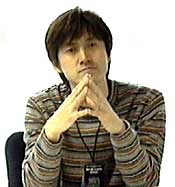by Luis Reyes
|
Production I.G's reputation in America precedes it, being one of the first companies to penetrate the American theatrical market with a feature film not aimed at kids or the family. "Ghost in the Shell," though not a box office smash, was a critical and fan success. It opened the door for a host of other anime titles to cross the Pacific into the American mainstream market. Now, rumors abound about a "Ghost in the Shell 2" and raves surround "Blood: The Last Vampire" and "Jin-Roh" which have recently ended successful Japanese theatrical releases. Takayuki Goto, the eponymous 'G' of Production I.G, speaks casually with Akadot about his career and sheds some light on the digital and global future that awaits the famed production studio. But I began my brief interview by asking about the role of the director in an animated series or film:
TG: When you say "director" do you mean "director" as of the director of production or "the Director?"
If you are talking about "the Director" of the whole work, then, no I have never done that before. There is a
position called "sakuga-kantoku" (illustration director) where the person corrects and edits what the animator
has created.
So the job of a director is to shape the look of the piece by telling people what to do? TG: Not direct people by telling them what do, but ... well, for example the drawings are done by several
animators who all work on one project because there are so many illustrations that need to be done. But each of the
drawings is a little different because each person has his own style, even though they are drawing the same character.
So I direct this team of animators so that there's uniformity in the images. So it is not exactly "directing" in the
sense that you are telling people "do this, do that."
[Even in something as necessarily uniform as a moving animated image there is multitudinous diversity as each artist's own personal aesthetic leaks into the work. The job of the animation director, then, is to bridle the idiosyncrasies of each cel, indelibly left there by the artists, to create a fluid image with a focused aesthetic.] And how about when you serve as a character designer? TG: That is another type of directing. I design the character then the "genga-man," key animator,
comes in and draws my character and then we edit it together.
What project are you most proud of? TG: "Akai Koudan Julian" (Red Shooting Julian) because I created the characters.
I conceived of it myself. That is why this is one of my favorites.
[Shifting focus from the artistry of animation to the future of Production I.G, I feel as if Goto-san could have regaled me for hours with the intricacies of animation production, how an animation director harnesses disparate elements into a cohesive whole. Goto-san loves what he does and, consequentially, he can engage in the top-level management of his company while simultaneously delving into the most minute details of the animation process.] What is in the future of Production I.G? TG: Of course we are all aiming to utilize digital technology more like in "Blood," which is an example
of the most cutting edge techniques. But using digital technology depends on each project. There are times when you
shouldn't use digital, so it all varies by case.
Could you describe the process of creating full digital anime? TG: I work mostly on cel animation so I really don't understand it well myself, but as far as I know,
we use a software called "Animo." It's animation software. And right now we are using other software with it,
mixing technology to create the animation.
|

